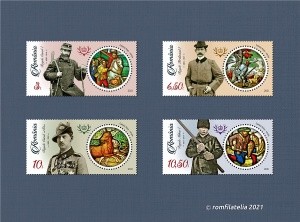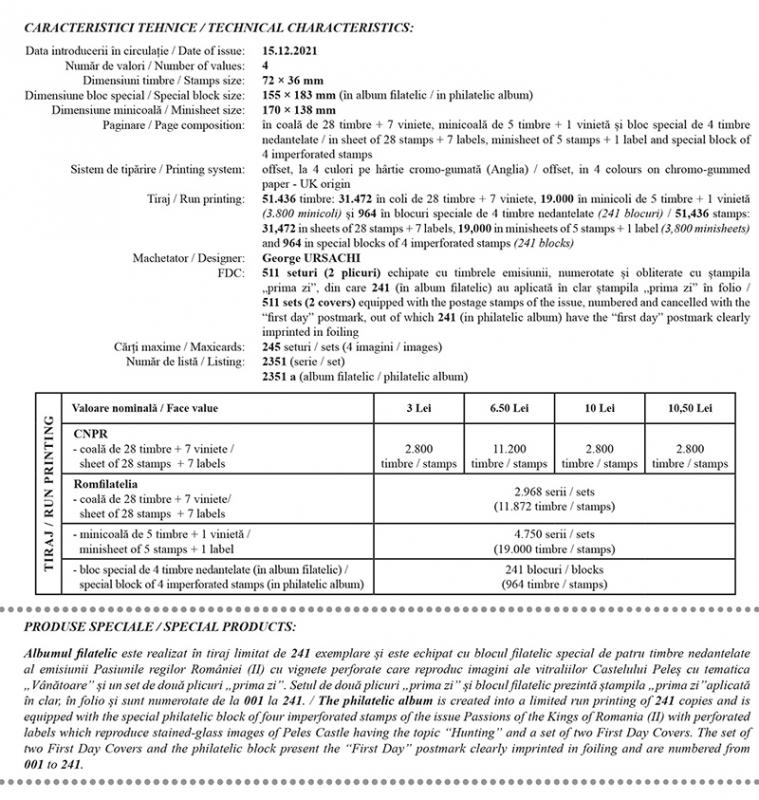 Romfilatelia introduces into circulation on Wednesday, December 15, 2021, the postage stamps issue The Passions of the kings of Romania (II), which explores the interests of Romanian monarchs beyond their official occupations, involvement in state affairs, approaching an exciting topic – Hunting.
Romfilatelia introduces into circulation on Wednesday, December 15, 2021, the postage stamps issue The Passions of the kings of Romania (II), which explores the interests of Romanian monarchs beyond their official occupations, involvement in state affairs, approaching an exciting topic – Hunting.
The postage stamps issue consists of four postage stamps, two First Day Covers and a set of four maxicards, for the maximaphily enthusiasts and is completed by a special philatelic block of four imperforated stamps with eight perforated labels and a set of two First Day Covers, having the First Day postmark clearly imprinted in foiling, both products being numbered and inserted in a philatelic album created in an elegant graphic concept.
The passion for hunting has existed among the representatives of all royal families of Europe. In Romania, we find, of course, this passion, well supported by the richness of the fauna that is the object of hunting.
Throughout his life, for King Carol I, hunting was perceived as a civilized way of showing respect for a long tradition, a continuation of ars bellorum (art of war), the King being educated and trained in the best military schools in Europe. During his time, on the lands of Buzau where he was present at bear hunting, the mansion of Rusetu was built, frequented by all kings of Romania and later by the representatives of the communist nomenclature.
The royal hunts took place with the participation of foreign guests, members of the royal houses of Europe, and the invitation to hunt was considered a sign of high esteem from the king. Along with them, the members of the representative families of the Romanian aristocracy also participated in the organized hunting expeditions.
Considered as an exceptional architectural ensemble, Peles and Foisor Castles present symbols that pay homage to the passion for hunting by decorating pieces of furniture and the existence of stained-glass windows, bas-reliefs depicting animals or hunters, trophies of animals hunted by royal families, hunting emblems or collections of old hunting weapons.
If we add to these the impressive Flemish tapestry, entitled Wild Boar Hunting and Falcon Hunting, we manage to convince ourselves that hunting was a passion of all kings of Romania.
We must not understand that the royal hunt took place anywhere and in any way. A clear description of the laws that were strictly complied with is made by Her Majesty King Michael I: “Our hunting laws were very well developed, completely different from what it is now. There were periods of time allowed for each type of game. Some animals could only be hunted with special permission, they were protected… bears, for example. Fallow deer only existed in closed parks… it was forbidden to shoot songbirds. Then the deer: their size and number were regulated in our country. You weren’t allowed to shoot anything and everything… just to break world records”. (Interview taken by Andrei Savulescu in 1996).
Of all birds and animals hunted, part was retained for the needs of the Royal Palace and the rest was sold to ensure the partial financing of the expenses incurred by the maintenance of the hunting grounds.
In love with the hunting area in the Gurghiului Mountains, Ferdinand I built a hunting lodge in Lapusna, with an architecture similar to Peles Castle. It is the place where Carol II later organized a hunt, having among the guests King Alexander of Yugoslavia (married to Princess Marioara of Romania). The photos taken show the horns of hunted deer as exceptional trophies.
Carol II and his son Michael had the most attendances at royal hunts. The king was not only passionate about hunting but also about hunting weapons. These include the weapon produced by Holland & Holland, with a bone bed, a Zeiss rifle sight and oval gold ornaments, with the king’s monogram and the royal crown. This weapon was confiscated and modified for dictator Nicolae Ceausescu, who often used it.
King Michael I began hunting at the age of 11. An episode remembered in the memory of the participants in a partridge hunt in Sinaia-Livada (Timis) is the one of September 1936, when the king’s son, “Mihaita” set the Romanian record since then, with 89 partridges hunted in one day.
With a fine sense of humour, King Michael I confesses to the author of the book An Interrupted Reign (Philippe Viguié Desplaces): “My father greatly encouraged my passion for hunting. Until the moment I ended up shooting almost as well as he did, maybe even better… What he liked less”.
Among the places frequently found for the organization of royal hunts were Valea Siretului (deer hunting), Scrovistea, a royal estate where ducks, geese and wild boars were abundant, Gheboaia, the estate of the Sutu family, a place where Eurasian woodcocks were found. Hunting events were organized on the lands near Savarsin Castle during the reign of King Michael I. There were many wild boars and deer in the young forest of the area.
It should be noted that King Carol II and Michael also participated in hunting events organized outside the borders of the country, in Czechoslovakia, France and Germany.
In forced exile, King Michael I was invited to several hunting events as a guest of the Queen of England or the royal family of Denmark.
It is worth mentioning the presence of King Michael I at a moose hunt in Sweden in 1949, together with Prince Wilhelm of Sweden, King Frederick of Denmark and Prince Axel of Denmark.
The stamps of the issue with the face values of Lei 3, Lei 6.50, Lei 10 and Lei 10.50, reproduce the portraits of the kings of Romania Carol I, Ferdinand I, Carol II and Michael I in appropriate attire to the hunting grounds next to symbolic scenes of the royal hunts found in the stained-glass suite of Peles Castle. It should be noted that King Michael I is represented as a child-hunter.
Romfilatelia thanks Mr. Narcis-Dorin Ion, General Director of the Peles National Museum and the team, as well as Dr. Cristian Anita, Director of the National Archives of Romania and the team, for the documentary and photographic support provided to the development this postage stamps issue.



